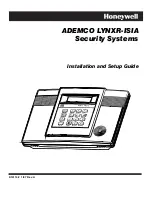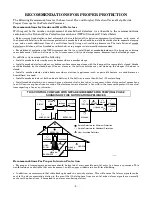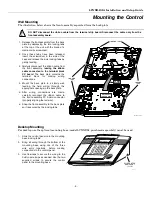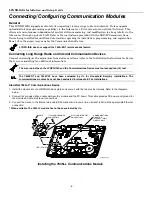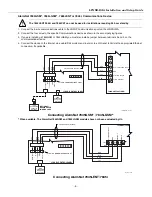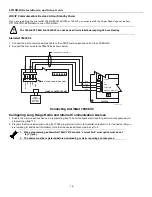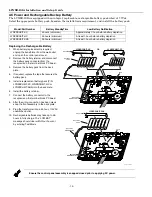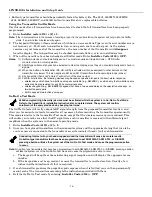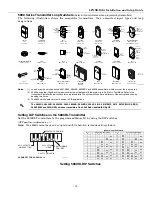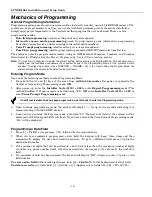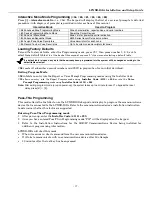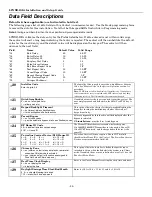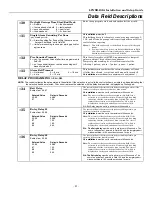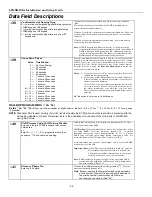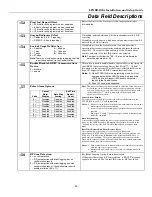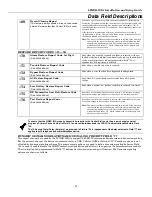
LYNXR-ISIA Installation and Setup Guide
- 14 -
•
Button-type transmitters should be periodically tested for battery life. The 5801, 5802MN, 5802MN2,
5804, 5804BD, 5804BDV, and 5804E button transmitters have replaceable batteries.
Using the Transmitter Sniffer Mode
Use this mode after all transmitters have been entered to check that all transmitters have been properly
programmed.
1. Enter
Installer code (4112) + [#] + 3.
Note:
If the communicator is in the process of sending a report to the central station, the system will not go into the Sniffer
mode. If so, wait a few minutes and try again.
2. The keypad will display all zone numbers, which have a non-zero Zone Type (even if serial numbers were
not learned yet). Fault each transmitter in turn, causing each one to send a signal. As the system
receives a signal from each of the transmitters, the zone number of that transmitter will
disappear
from the display. The transmitters may be checked upon installation, or in an installed system.
3. When all transmitters have been checked, exit Sniffer mode. Enter
Installer Code (4112)
+
OFF.
Notes:
(1) Sniffer mode does not automatically expire. You must manually exit (Installer Code + OFF) Sniffer
mode to return to normal operation.
(2) All BR-type units must physically be activated to clear the display, since they do not automatically send check-in
signals.
(3) When one button of a transmitter (RF, UR, or BR) is activated, all zones assigned to other buttons on that
transmitter are cleared. This also applies to 5816 and 5817 transmitters that have multiple loops (zones).
(4) Any transmitter that is not “entered” will not turn off its zone number.
(5)
For SIA installations, the following devices may be used as specified for panic (24-hour) alarm response:
•
wireless keys which have two-button panic pairs available (e.g., 5804BDV), on which only the two-button panic
pairs may be programmed for any 24-hour alarm response
•
wireless keypads (e.g., 5828/5828V) keypads that have a two-second delay on the special function keys, or
two-button panic pairs
•
built-in keypad’s two-button panic pairs
Go/No Go Test Mode
5804E encrypted (High-Security) devices must be activated while the system is in Go/No Go Test Mode.
Refer to the transmitter’s installation instructions for complete details. The system will confirm
enrollment of the encrypted device by beeping two times.
The Go/No Go
tests will verify adequate RF signal strength from the proposed transmitter location, and
allow you to reorient or relocate transmitters if necessary, before mounting the transmitters permanently.
This mode is similar to the transmitter Test mode, except that the wireless receiver gain is reduced. This
will enable you to make sure that the RF signal from each transmitter is received with sufficient signal
amplitude when the system is in the normal operating mode.
1. Enter
Installer Code (4112)
+ [#] + 8
.
2. Once you have placed transmitters in their desired locations and the approximate length of wire to be
run to sensors is connected to the transmitter's screw terminals (if used), fault each transmitter.
Conducting this test with your hand wrapped around the transmitter will cause inaccurate results.
On button type transmitters that have been programmed to set ARM AWAY, ARM STAY, or DISARM,
pressing a button will take the system out of the Go/No Go Test mode and cause the programmed action
to occur.
Note:
On button type transmitters that have been programmed to set ARM AWAY, ARM STAY, or DISARM, pressing a button
will take the system out of the Go/No Go Test mode and cause the programmed action to occur.
a. The keypad will beep three times indicating signal reception and will display the appropriate zone
number.
b. If the keypad does not beep, reorient or move the transmitter to another location. Usually a few
inches in either direction is all that is required.
3. If each transmitter produces the proper keypad response when it is faulted, you can then permanently
mount each of the transmitters according to the instructions provided with them.
4. Exit the Go/No Go
Test mode by entering:
Installer Code (4112)
+
OFF.

